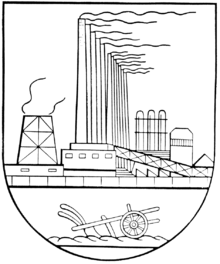Coat of arms of the city of Leuna
The coat of arms of Leuna is the official emblem of the city of Leuna in Saxony-Anhalt .
Blazon
The official blazon of the current coat of arms reads: "In silver above a black-grooved green wall covered with a silver ploughshare , a black-grooved red chimney, accompanied by stakes of three six-pointed green stars ."
history
The development of a coat of arms for the city of Leuna as well as a coat of arms documentation for the purpose of the approval procedure by the state government were commissioned in 1996 to the Magdeburg municipal heraldist Jörg Mantzsch, in order to have an officially approved in the seal, on the flag of the city and in other use in accordance with the rules of heraldry To carry coats of arms as the emblem of the place
Leuna originally consisted of the six communities Leuna, Ockendorf, Rössen, Göhlitzsch, Daspig and Cröllwitz. These were small villages, the residents of which lived mainly from agriculture .
In 1930 the union of now 5 communities resulted in the formation of the Leuna association. By then, the Leuna plant with its first 12, then 13 high chimneys had been built. The municipal council decided to use the 12 chimneys of the Leunawerk, a plow and a reference to the original municipalities marked with stars and initials in an image seal. Such a seal was then also used - mind you, as an image seal, not as a coat of arms seal.
If the municipal council declared in 1930 that this symbolism in the coat of arms was not absolutely necessary , soon afterwards the idea of a coat of arms was considered. The Merseburg district committee rejected this request and the template made and advised to consult the Prussian State Archives and an experienced heraldist.
In a letter dated January 12, 1931, Walter Möllenberg from the State Archives in Magdeburg criticized the Leuna model with smoking chimneys, plow, stars and letters as a coat of arms and assessed negatively. Professor Möllenberg also recommended commissioning a heraldist to design the coat of arms and not to develop it on his own.
In the period that followed, Leuna carried his picture seal, then a lettering seal and a picture seal with an imperial eagle and swastika , in GDR times with a state emblem, and after the fall of the Wall from 1990, again the picture seal with smoking chimneys behind a plant and with a plow.
In a letter dated January 12, 1995, the state main archive of Saxony-Anhalt rejected the coat of arms with the above symbolism, which had been used since 1976, as incorrect in its representation and illegal in its use. The following arguments were essential in the evaluation:
- The coat of arms has the character of a pictorial drawing - not of heraldic symbolism. The symbols used are those that are customary in heraldry. This of course includes the use of new symbols (e.g. from industry).
- In accordance with the heraldic principle pars pro toto (part of the whole), only one essential element needs to be picked out and depicted when depicting the industry. The same applies to the plow, which in the most recent drafts was even designed with a tractor.
- The coat of arms must be correctly tinged be. This means that the coat of arms and the symbols on it must have colors (tinctures) that correspond to the basic rule of Tingistics.
Approval from the legislature to use the coat of arms was only to be expected when these conditions were met.
In 1996 the city of Leuna decided to provide the city coat of arms with the following symbols and colors:
- Instead of 12 chimneys and an entire plant, only 1 chimney without smoke is used. The chimney is red and grooved. It symbolizes the Leuna factory as an outstanding industrial location that shapes the city.
- The chimney is accompanied by 6 green six-pointed stars, ie 3 stars on each side. The stars symbolize the original 6 independent villages from which today's city emerged.
- The base of the shield is green and grooved. It thus represents a heraldic symbol of urban fortification. The color green refers to Leuna as a garden city, because this is how the city was originally planned and built.
- Instead of the whole plow, a stylized silver ploughshare was chosen to cover the base of the shield.
In February 1996 the city council decided to bring the heraldist Jörg Mantzsch's submission into the approval process. Approval was granted on June 11, 1996 by the Halle regional council.
Individual evidence
- ↑ Main statute of the city of Leuna from November 20, 2006 ( page no longer available , search in web archives ) Info: The link was automatically marked as defective. Please check the link according to the instructions and then remove this notice.


